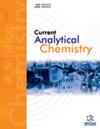基于纳米材料的护理点设备综述:以心血管疾病为重点
IF 1.7
4区 化学
Q3 CHEMISTRY, ANALYTICAL
引用次数: 0
摘要
背景:纳米技术是纳米科学与生物学和生物医学的结合,利用纳米技术进行医学和生物学研究这一课题目前正受到广泛关注。纳米材料的尺寸、形状和成分多种多样,被广泛应用于各种领域。它们的激发潜能主要是提高我们识别自然发生过程的能力。方法:此外,护理点(POC)方法可在家中、医生办公室或其他任何地方提供快速简便的药物分析。妊娠测试和血糖测试就是两个最著名的例子。从更全球化的角度来看,它们为挽救不治之症患者的生命提供了诱人的前景:其快速、有时是瞬时的数据大大缩短了分析时间,而且其更经济的变体使医疗机构、世界各地的个人甚至发展中国家都能使用。在疾病分析中确定生物标志物,如酶、蛋白质、循环肿瘤细胞、微小化合物和生物样本中的 DNA/RNA,包括全血清、血液、唾液、血浆、体液、脑脊液和尿液,也可纳入应用范围。结果在全球范围内,心血管疾病(CVD)是导致死亡的主要原因。找到心脏生物标志物对于心血管疾病的诊断、管理和预防至关重要。通过提供有关病人心脏健康的重要信息,这些指标可以帮助医生做出最佳决策和提供最佳护理。心脏生物标志物鉴定的 POC 方法大大提高了心脏治疗的效率、及时性和以病人为中心的原则,从而改善了病人的预后和医疗服务。因此,本次调查的主要重点是目前市场上销售的、在过去五年内发表的用于评估心脏生物标志物的 POC 仪器和传感器。我们讨论了最近利用各种尖端技术、复杂材料和分析方法开发的 POC 设备。结论:本研究还概述了几家公司及其销售的用于心功能监测和快速、精确诊断心衰的产品。最终,我们得出了有关用于医疗应用(即心血管疾病)的 POC 设备的重要结论。本研究还考虑了全球市场价值和 POC 设备的潜在发展方向。本文章由计算机程序翻译,如有差异,请以英文原文为准。
A Review on Nanomaterial-based Point-of-Care Devices: Emphasis on Cardiovascular Diseases
Background: The subject of medical and biological research using nanotechnology, which blends nanoscience with biology and biomedicine, is currently gaining a lot of attention. Nanomaterials come in a wide range of sizes, shapes, and compositions and are widely used in various applications. Their stimulating potentials mainly enhance our capacity to identify naturally occurring processes. Methods: Moreover, point-of-care (POC) methods offer quick and easy medication analysis at home, in a physician's office, or anywhere else. The pregnancy test and the blood glucose test are the two most well-known examples. From a more global standpoint, they offer the enticing prospect of saving lives from incurable illnesses: their rapid, sometimes instantaneous data significantly minimize analysis times, and their more economical variants make them accessible to healthcare facilities, individuals worldwide, and even in developing countries. Determining biomarkers in disease analysis, such as enzymes, proteins, circulating tumor cells, tiny compounds, and DNA/RNA in biological examples, including full serum, blood, saliva, plasma, fluid, cerebral spinal, and urine, may also be included in applications. Results: Globally, cardiovascular diseases (CVDs) are the primary cause of death. Finding cardiac biomarkers is crucial for the diagnosis, management, and prevention of cardiovascular diseases. By giving vital information about a patient's cardiac health, these indications help doctors make the best decisions and give the best care. The efficiency, promptness, and patient-centeredness of cardiac treatment are significantly enhanced by POC methods for cardiac biomarker identification, which improves patient outcomes and healthcare delivery. For this reason, the primary emphasis of this investigation was on POC instruments and sensors that are now available commercially and have been published within the previous five years for the assessment of cardiac biomarkers. We discuss the POC devices that have been developed recently using a variety of cutting-edge technologies, sophisticated materials, and analytical methods. Conclusion: The current study also includes an overview of several companies and the products they sell for cardiac function monitoring and rapid, precise heart failure diagnosis. Ultimately, important conclusions are reached about POC devices for medical applications, namely for CVDs. The global market values and potential directions for POC device development are also taken into consideration.
求助全文
通过发布文献求助,成功后即可免费获取论文全文。
去求助
来源期刊

Current Analytical Chemistry
化学-分析化学
CiteScore
4.10
自引率
0.00%
发文量
90
审稿时长
9 months
期刊介绍:
Current Analytical Chemistry publishes full-length/mini reviews and original research articles on the most recent advances in analytical chemistry. All aspects of the field are represented, including analytical methodology, techniques, and instrumentation in both fundamental and applied research topics of interest to the broad readership of the journal. Current Analytical Chemistry strives to serve as an authoritative source of information in analytical chemistry and in related applications such as biochemical analysis, pharmaceutical research, quantitative biological imaging, novel sensors, and nanotechnology.
 求助内容:
求助内容: 应助结果提醒方式:
应助结果提醒方式:


